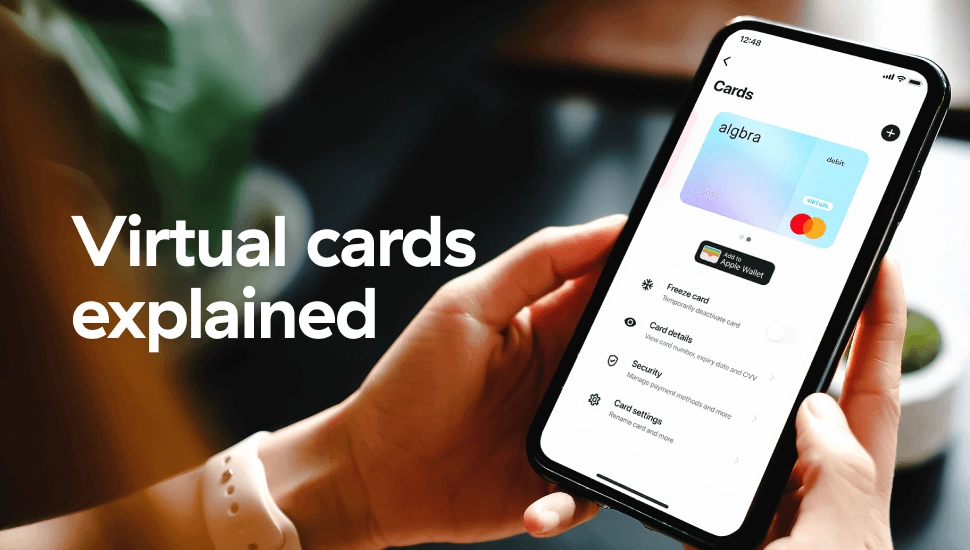Introduction
A virtual card is a digital version of a physical debit or credit card. It is typically used for online transactions and offers enhanced security features compared to traditional cards. Here are the key aspects of a virtual card:
Digital Nature: Unlike physical cards, virtual cards exist solely in digital form. They can be generated through a bank’s website or mobile app.
Unique Card Number: Each virtual card comes with a unique card number, expiration date, and CVV, similar to a physical card. These details are used for online purchases.
Working

Here’s how it functions:
Issuance: Virtual debit cards are typically issued by banks or financial institutions through their online banking platforms or mobile apps. They are linked to your existing bank account.
Card Details: Upon issuance, you receive card details such as the card number, expiration date, and CVV code, just like a physical card. However, these details are displayed digitally within the bank’s app or website.
Usage: You can use a virtual debit card for online purchases, subscriptions, or other digital payments by entering the card details at the checkout. Some virtual cards can also be added to digital wallets like Apple Pay or Google Pay for contactless payments.
Security: Virtual debit cards offer enhanced security features. Some banks allow you to generate new card details for each transaction or periodically change the CVV code. This reduces the risk of fraud and unauthorized use.
Control: Users often have more control over virtual cards. You can set spending limits, freeze or unfreeze the card, and view transaction history through the bank’s app or website.
Instant Access: Since the card is digital, there’s no waiting time for it to be mailed. You can start using it immediately after it’s issued.
Overall, virtual debit cards provide a convenient, secure, and flexible way to manage online transactions and protect against fraud.
Safety

Is it safe to use virtual debit card.
Using a virtual debit card is generally considered safe. It offers several advantages in terms of security as compared to traditional physical cards:
Reduced Risk of Fraud: Virtual debit cards are designed for online use, and many banks allow you to generate new card numbers for each transaction. This makes it difficult for fraudsters to use your card details for unauthorized purchases.
Enhanced Security Features: You can often set spending limits, expiration dates, and even specify the types of transactions (e.g., only for online purchases) for your virtual card. This control reduces the risk of misuse.
Easily Managed: Virtual cards can be easily managed via your bank’s app or website. It allows you to quickly freeze, unfreeze, or cancel the card if you suspect any fake activity.
No Physical Card to Steal: Since there’s no physical card, there’s no risk of it being lost or stolen. All transactions are conducted using digital details, which are typically stored securely within your banking app.
Temporary Use: Some virtual debit cards can be set up for one-time use or for a limited period. It helps to further reduce the chances of long-term fraud.
Encryption and Secure Transmission: Financial institutions use advanced encryption and secure transmission protocols to protect your card details when they are generated and used online.
While virtual debit cards are secure, it’s still important to follow best practices for online safety. It can be using strong passwords, enabling two-factor authentication, and monitoring your account for any suspicious activity.
Protection

Protecting your virtual debit card from being hacked involves a combination of proactive measures, secure practices, and constant vigilance. Here’s a detailed guide:
1. Strong Passwords and Authentication
Use Strong Passwords: Create complex and unique passwords for your banking app and related accounts. Avoid using easily guessable information.
Enable Two-Factor Authentication (2FA): Activate 2FA for your banking app. This adds an extra layer of security by requiring a second form of verification, such as a code sent to your phone.
2. Secure Your Devices
Update Software: Keep your operating system, apps, and antivirus software up to date to protect against vulnerabilities.
Use Trusted Security Software: Install reputable antivirus and anti-malware programs to guard against malicious attacks.
Lock Your Devices: Use strong passwords, PINs, or biometric security features (like fingerprint or facial recognition) to lock your phone and computer.
3. Be Cautious Online

Avoid Public Wi-Fi: Don’t access your banking app or make transactions over public Wi-Fi networks. Use a secure, private network or a VPN.
Phishing Awareness: Be wary of emails, messages, or websites that ask for your card details or login information. Verify the sender’s authenticity before clicking on any links or providing information.
4. Monitor Your Accounts
Regularly Check Transactions: Frequently review your bank statements and transaction history for any unauthorized activities.
Set Up Alerts: Enable transaction alerts via SMS or email to receive real-time notifications of account activity.
5. Use Bank-Specific Features

Virtual Card Controls: Many banks offer features such as temporary card numbers, spending limits, and specific usage settings (e.g., online purchases only). Utilize these features for added security.
Freeze/Unfreeze Options: Use the option to freeze your virtual debit card immediately if you suspect any suspicious activity.
6. Secure Data Storage
Avoid Saving Card Details: Don’t save your card details on websites or in browsers unless absolutely necessary. If you do, ensure the site is reputable and uses encryption.
Use Encrypted Digital Wallets: If you store your virtual card in a digital wallet (like Apple Pay or Google Pay), ensure the wallet is encrypted and your device is secure.
7. Secure Communication

Bank Communication: Ensure any communication with your bank is through secure channels. Use the official banking app or website and avoid sharing sensitive information over email or phone unless you’ve initiated the contact through verified means.
8. Education and Awareness
Stay Informed: Keep yourself updated on the latest security practices and potential threats. Many banks and financial institutions offer resources on how to protect your accounts.
Training and Awareness: If you share your banking environment with family members or colleagues, educate them about best practices for security.
By implementing these practices, you can significantly reduce the risk of your virtual debit card being hacked. It ensures your financial information remains secure.
Examples of Virtual Card Services in India
- HDFC Bank NetSafe: HDFC Bank offers the NetSafe card, a virtual card service for secure online shopping.
- ICICI Bank Virtual Credit Card: ICICI provides virtual credit cards that can be used for e-commerce transactions.
- SBI Virtual Card: State Bank of India offers virtual cards that can be created through their online banking platform.
